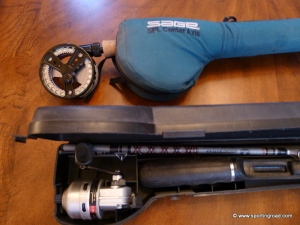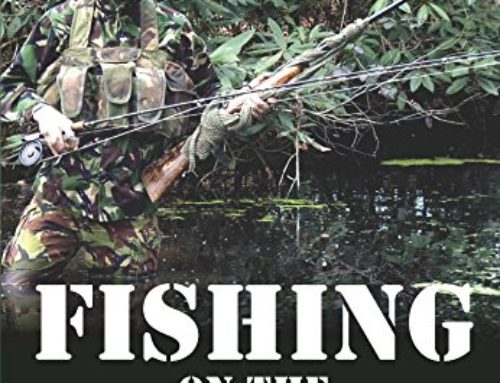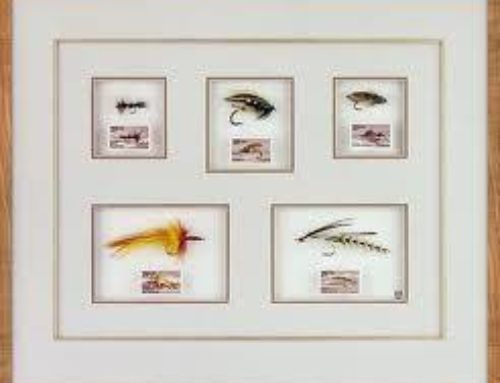My childhood fantasies still haunt me. Nearly every day in the winter, we would walk down to the neighborhood pond and play hockey until we were called in for dinner or until darkness made it no longer able for us to play. We do the same thing now with polo. And, in the summer, we fished the same pond from dawn to dusk for bass. And, I still do now with fly rods for trout, as much as possible with work and other hobbies, so sometimes I am left with fantasizing about them all.
In my childhood, my buddy and I fished, nearly exclusively, with the Diawa  Minicast rod and reel. And, now, I do the same with light weight fly rods, from 0-weight to 3-weight rods for trout. Sure we had other fishing rods, and do now as well, but these were our favorites, and still are. The fish felt bigger and we lost fewer of them. The Diawa Minicast it advertised that, “you’ll always have a high-quality ultralight set-up that’s ready to catch fish wherever you are… which matches an ultralight reel featuring an aluminum alloy body and nose cone, smooth disc drag and easy push button … with compartments which fit inside your suitcase or under car seat.”
Minicast rod and reel. And, now, I do the same with light weight fly rods, from 0-weight to 3-weight rods for trout. Sure we had other fishing rods, and do now as well, but these were our favorites, and still are. The fish felt bigger and we lost fewer of them. The Diawa Minicast it advertised that, “you’ll always have a high-quality ultralight set-up that’s ready to catch fish wherever you are… which matches an ultralight reel featuring an aluminum alloy body and nose cone, smooth disc drag and easy push button … with compartments which fit inside your suitcase or under car seat.”
I guess I still haven’t grown up, as I still fancy ultralight rods and flies. In 1982, Howard Steere designed the Orvis Superfine 2-weight, then the Orvis Superfine 1-weight, which truly transported fly fishing into the world of ultralight. Shortly thereafter, Jerry Siem moved from Winston to Sage evolved ultralight fishing by designing the first of three revolutionary families of truly unrivaled ultralight fly rods. First was the Sage TXL 0-weight.
This was followed in of 1997, with the whole family of Sage SPL ultralights, which were revolutionizing in featuring the latest newest materials with strength and backbone. The Sage LL series which went down to 2-weight, is sill one of my favorites together with the Winton IMG6, which was only available down to 3-weight at the time. Rim Chung, my fishing buddy, considered the IMG6 heavy and slow compared to the new Sage rods of this era, a point we disagreed upon. This also resulted in a wave of new fly lines. Before that, one was nearly forced to invent ways of outfitting these rods with suitable lines, such as the .027 running lines, which were intended for salt water fly line backings, but made great ultraweight fly lines, as only one or two lines were available and they were not ideal.
These ought-weight 54 grain lines were advertised to cast “without any effort for undetectably stealthy fishing.” 3M teamed with Sage to invent the Sage Quiet Taper line along with the SPL rods. Unlike the advertisement, we didn’t fish them as specialty rods; we fished them hard, every day and nymphing, often with a lot of weight. We fished it from the streams in Colorado to the big rivers of Wyoming and Montana, and on the huge monsters of the San Juan and other famous trophy trout streams. My fishing pal, Rim Chung, a master of the light line nymphing school criticized to Jerry Siem at several fly fishing shows that while the ultralight movement was appreciated, the rods were too whippy and too soft in the butt section.
The rods weighed some 7 pounds and they caught fish of the same size, with ease and protected the 7x tippets we used with size. Sage announced the discontinuation of the SPL series in 2001 and in 2002 the next generation of Sage ultralights—the SLTs and while the color and materials had changed, many claimed that these rods had the same feel, performance, and dimensions as the SPLs. We believe they were better, as they retained the same ultralight weight and were a tiny bit stiffer in the butt and mid-sections, while retaining the same flexibility in the tip, which resulted in saved tippets at the very small range we were using, which were also now developing into 8-10x range, which was unheard of before and fluorocarbon was also coming onto the scene, which was not all that it was advertised to be in its holding strength despite whatever advantageous it might offer in stealth. Winston followed with the WT and the LT. The LT series were amazing rods in the shorter lengths, but tended to have negative tip action, especially as they approached the 9 foot length.
In comparing WT and LT actions, I considered the WT’s to be full flex rods, and LT’s as mid flex action rods which was verified by the Orvis Full Flex Index. But, the WT and LT are truly Winston’s bread and butter action rods.
Sage even went as far as to market a double ought weight, which even some of our die hardest lightweight fans, found to be something of a marketing gimmick for practical use on trout. K 2005 Jerry Siem has created another generation of incredible ultralights –the TXLs, which to us, weighed and compared the same as the SPL, but was noticeably stiffer. It was advertised to come with new double taper lines, which were noticeably heavier than those previously marketed with these rods. Understandably, the rods were also noticeably stiffer, often a weight higher than those advertised, compared to their predecessors.
Mr. Siem has commented that the SPLs and SLTs required a little finer hand (more feedback and casting skill) to cast them. And in the TXLs there is more power in the center and upper sections that makes today’s casting a little easier. Winston followed with the BII’s, which in my opinion, are abit astride of the Winston realm, as there better rods with similar action from other manufacturers. I still prefer the LT and the WT, or even the IMG6 for true Winston actions.
I have often asked Rim Chung about the disadvantage of casting light weight lines, especially, in adverse conditions, such as high winds. He argues that a caster of a 7-weight rod has the disadvantage over the 0-weight caster. If one considers the reality of the situation — the diameter of larger lines increases and actually presents more surface area and resistance to the wind, as well as increased drag on the water, thus doubling the problem for a nymph fisherman.
There are a number of new products on the horizon, which we are still testing and are too new to deserve a review, if your objective is seeking lifetime satisfaction. Which raises another point upon which Rim and I disagree–his father had two wives in Korea, which was common for this era, and he says that one never must view a fly rod in this vein and that “fly rods are more like women, where one may suit your fancy on a particular day, but a man should be free to covet another on a different day or stream, so why limit yourself to fantasizing of just one as the image of perfection?” Or, you have the other end of the spectrum of unconcern for the latest, such as my friend Nick Sawyer, grandson of the late inventor of the Pheasant-tail Fly, who couldn’t tell me of what weight his rods were, only that they were “the ones my grandfather used and they always caught, so I haven’t inquired further of them,” which is certainly another valid theory on the merits of fantasizng about rods or women.





